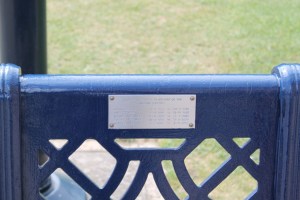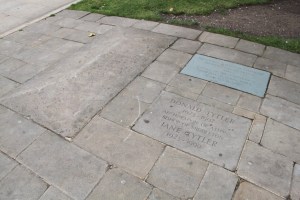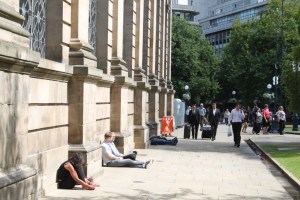
The Birmingham bombings memorial, prominently located beside one of the main paths through the churchyard
From Howard’s Archaeodeath blog. In archaeological discussions, the date-range for cemeteries and churchyards is often taken from the memorials or dated graves. When these run out, the site is presumed to be abandoned.
We often don’t muse about what happens next. It is often implicitly assumed that the site rapidly becomes invisible unless marked by prominent monuments. Even the function and significance of these structures might be soon forgotten. Of course we encounter many instances where burial sites are reused after long periods of disuse. However, the absence of evidence between use and reuse is so often taken as evidence of absence. Often this is justified, but is it always so?

Second view of the Birmingham bombins memorial – traces of where formerly wooden crosses had been appended can be clearly seen
So how quickly did cemeteries ‘disappear’ once ‘fresh’ burials cease to be inserted? Were they abandoned utterly? Or did they persist as vibrant memoryscapes? Or do post-burial cemeteries remain significant but at a lower-level of use-intensity: a kind of half-light undead existence?
The modern world provides many examples of cemeteries that, once abandoned, can be rapidly reused for other purposes and their funerary functions forgotten. Equally though, our British townscapes and landscapes are punctuated by thousands of abandoned cemeteries, burial grounds and churchyards with memorials in situ or at least still on display. These are still important and often protected (listed) components of our historic environment; they linger on with no or infrequent use as ‘heritage’ but also as used spaces in a variety of sometimes eclectic and complex uses and intermittent memorial practices.
For example, Birmingham Cathedral’s churchyard is instructive in its tenacity as a commemorative environment long after its disuse for burial. As mentioned in a previous blog, it is the tombs and memorials from the period of use as cemetery that are one dimension to this tenacity. St Philip’s churchyard was closed in 1859 and converted into a park in the early 20th century. While most memorials were removed over time, a selection have endured. They were retained for their physical permanence, artistic value and the stories they tell.
Yet St Philip’s churchyard endured as a commemorative environment post-burial in other ways. A range of new memorials were added during the later 19th, 20th and now into the early 21st centuries.
For the 19th century, the most prominent is an obelisk commemorating war hero Colonel Frederick Burnaby of the Horse Guards. He was killed by a spear in the throat in the short but bloody battle of Abu Klea in 1885 during the Desert Column’s attempt to save General Gordon besieged in Khartoum. By the time his memorial was raised, the churchyard had been closed for over 20 years, and yet he is afforded a prominent obelisk larger than any monument apposite for a cemetery. Still, it is very appropriate for such a larger-than-life personality and someone of heroic status.
There is also a mid-19th century fountain, transferred from a demolished church of Christchurch at the turn of the century. Today, this fountain has been ascribed a memorial function: the angel is given flowers, although the back-side of the memorial is scrawled with graffiti.
For the 20th century, the most prominent cenotaph in Birmingham Cathedral’s grounds commemorates those killed by the IRA bombs of 1974. Recently renovated, it bears the traces of absence upon its sides of formerly present crosses.
There are also more personal memorials, including the ubiquitous memorial benches with plaques, one commemorating the sisters of the same family. There are also memorial trees. There is an oak planted by Lady Diana; her secular-saintly and commemorative deeds in life readily transferred here as elsewhere to honour her own memory.
There are also indications, as identified elsewhere in churchyards, that the cremated dead, in certain circumstances, might be making their way back into these spaces. For while there was no garden of remembrance, the size, scale and association with other memorials suggest that some recent plaques commemorate sites of the interment of ashes.
We have already mentioned in a previous blog how some memorials are a focus of ongoing memorial practice, notably Badger and Reap’s memorial. Thus, ongoing memorial practices can focus on graves of war heroes and other celebrities.
Most recently, there are indications of more ephemeral monuments; the flowers on the angel fountain, and a temporary memorial beside Badger and Reap’s memorials among them. Another example is a wicker sculpture, one of a series throughout the city commemorating the centenary of the First World War.
And of course, in addition to these memorial uses, the churchyard is a place to walk through and rest in, a place for the living as much as a repository of tombs and memorials. There is plenty of evidence, despite the well-tended nature of the space, for subaltern uses of the space, such as the song lyrics daubed onto the surface of one structure.
In summary, this post-burial churchyard has remained an active and intermittent commemorative environment for well over a century and a half. It has evolved as a space in that time, but has retained a focus of both ongoing monumental and more ephemeral commemorative practices.
It will be interesting to see how this kind of spaces morphs through the 21st century. If not fully living environments of commemoration, these urban churchyards might be described at the very least undead graveyards in memorial terms.










